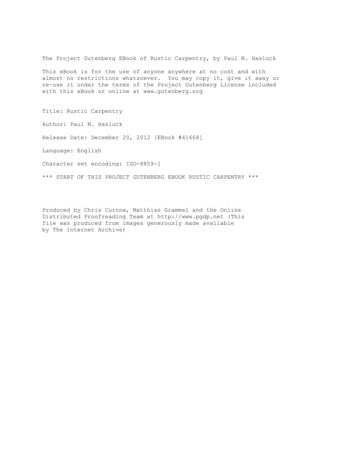
Transcription
eBookDataManagement 101on DatabricksLearn how Databricks streamlinesthe data management lifecycle
E B O O K : D ATA M A N A G E M E N T 1 0 1 O N D ATA B R I C K SIntroduction2Given the changing work environment, with more remote workers and new channels, we areseeing greater importance placed on data management.According to Gartner, “The shift from centralized to distributed workingrequires organizations to make data, and data management capabilities,available more rapidly and in more places than ever before.”Data management has been a common practice across industries for many years, althoughnot all organizations have used the term the same way. At Databricks, we view datamanagement as all disciplines related to managing data as a strategic and valuable resource,which includes collecting data, processing data, governing data, sharing data, analyzing it —and doing this all in a cost-efficient, effective and reliable manner.
E B O O K : D ATA M A N A G E M E N T 1 0 1 O N D ATA B R I C K SContents3Introduction2The challenges of data management4Data management on Databricks6Data ingestion7Data transformation, quality and processing10Data analytics13Data governance15Data sharing17Conclusion19
E B O O K : D ATA M A N A G E M E N T 1 0 1 O N D ATA B R I C K SThe challenges ofdata management4Ultimately, the consistent and reliable flow of data across people, teams and businessfunctions is crucial to an organization’s survival and ability to innovate. And while we areseeing companies realize the value of their data — through data-driven product decisions,more collaboration or rapid movement into new channels — most businesses struggle tomanage and leverage data correctly.DataManagementAccording to Forrester, up to 73% of company data goesunused for analytics and decision-making, a metric that isDataIngestionDataSharingcosting businesses their success.The vast majority of company data today flows into a data lake, where teams do data prepand validation in order to serve downstream data science and machine learning initiatives.DataTransformationand ProcessingDataGovernanceDataAnalyticsAt the same time, a huge amount of data is transformed and sent to many differentdownstream data warehouses for business intelligence (BI), because traditional data lakesare too slow and unreliable for BI workloads.Depending on the workload, data sometimes also needs to be moved out of the datawarehouse back to the data lake. And increasingly, machine learning workloads are alsoreading and writing to data warehouses. The underlying reason why this kind of datamanagement is challenging is that there are inherent differences between data lakes anddata warehouses.
E B O O K : D ATA M A N A G E M E N T 1 0 1 O N D ATA B R I C K S5On one hand, data lakes do a great job supporting machine learning — they have openformats and a big ecosystem — but they have poor support for business intelligence andsuffer from complex data quality problems. On the other hand, we have data warehousesthat are great for BI applications, but they have limited support for machine learningworkloads, and they are proprietary systems with only a SQL interface.
E B O O K : D ATA M A N A G E M E N T 1 0 1 O N D ATA B R I C K SData managementon Databricks6Unifying these systems can be transformational in how we think about data. And theDatabricks Lakehouse Platform does just that — unifies all these disparate workloads, teamsand data, and provides an end-to-end data management solution for all phases of the datamanagement lifecycle. And with Delta Lake bringing reliability, performance and security toa data lake — and forming the foundation of a lakehouse — data engineers can avoid thesearchitecture challenges. Let’s take a look at the phases of data management on Databricks.Learn more about theDatabricks Lakehouse PlatformLearn more about Delta Lake
E B O O K : D ATA M A N A G E M E N T 1 0 1 O N D ATA B R I C K SData ingestion7In today’s world, IT organizations are inundated with data siloed across various on-premisesapplication systems, databases, data warehouses and SaaS applications. This fragmentationmakes it difficult to support new use cases for analytics or machine learning. To supportthese new use cases and the growing volume and complexity of data, many IT teams arenow looking to centralize all their data with a lakehouse architecture built on top of DeltaLake, an open format storage layer.However, the biggest challenge data engineers face in supporting the lakehouse architectureis efficiently moving data from various systems into their lakehouse. Databricks offers twoways to easily ingest data into the lakehouse: through a network of data ingestion partners orby easily ingesting data into Delta Lake with Auto Loader.
E B O O K : D ATA M A N A G E M E N T 1 0 1 O N D ATA B R I C K S8The network of data ingestion partners makes it possible to move data from various siloedsystems into the lake. The partners have built native integrations with Databricks to ingestand store data in Delta Lake, making data easily accessible for data teams to work with.
E B O O K : D ATA M A N A G E M E N T 1 0 1 O N D ATA B R I C K S9On the other hand, many IT organizations have been using cloud storage, such as AWSS3, Microsoft Azure Data Lake Storage or Google Cloud Storage, and have implementedmethods to ingest data from various systems. Databricks Auto Loader optimizes file sources,infers schema and incrementally processes new data as it lands in a cloud store with exactlyonce guarantees, low cost, low latency and minimal DevOps work.With Auto Loader, data engineers provide a source directory path and start the ingestionjob. The new structured streaming source, called “cloudFiles,” will automatically set up filenotification services that subscribe file events from the input directory and process newfiles as they arrive, with the option of also processing existing files in that directory.Data ingestion on DatabricksLearn moreGetting all the data into the lakehouse is critical to unify machine learning and analytics.With Databricks Auto Loader and our extensive partner integration capabilities, dataengineering teams can efficiently move any data type to the data lake.
E B O O K : D ATA M A N A G E M E N T 1 0 1 O N D ATA B R I C K SData transformation,quality and processing10Moving data into the lakehouse solves one of the data management challenges, but in orderto make data usable by data analysts or data scientists, data must also be transformed intoa clean, reliable source. This is an important step, as outdated or unreliable data can lead tomistakes, inaccuracies or distrust of the insights derived.Data engineers have the difficult and laborious task of cleansing complex, diverse data andtransforming it into a format fit for analysis, reporting or machine learning. This requires thedata engineer to know the ins and outs of the data infrastructure platform, and requires thebuilding of complex queries (transformations) in various languages, stitching together queriesfor production. For many organizations, this complexity in the data management phase limitstheir ability for downstream analysis, data science and machine learning.
E B O O K : D ATA M A N A G E M E N T 1 0 1 O N D ATA B R I C K S11To help eliminate the complexity, Databricks Delta Live Tables (DLT) gives data engineeringteams a massively scalable ETL framework to build declarative data pipelines in SQL orPython. With DLT, data engineers can apply in-line data quality parameters to managegovernance and compliance with deep visibility into data pipeline operations on a fullymanaged and secure lakehouse platform across multiple clouds.
E B O O K : D ATA M A N A G E M E N T 1 0 1 O N D ATA B R I C K S12DLT provides a simple way of creating, standardizing and maintaining ETL. DLT data pipelinesautomatically adapt to changes in the data, code or environment, allowing data engineers tofocus on developing, validating and testing data that is being transformed. To deliver trusteddata, data engineers define rules about the expected quality of data within the data pipeline.DLT enables teams to analyze and monitor data quality continuously to reduce the spread ofincorrect and inconsistent data.“Delta Live Tables has helped our teams save time and effort in managingdata at scale.With this capability augmenting the existing lakehousearchitecture, Databricks is disrupting the ETL and data warehouse markets,which is important for companies like ours.”— Dan Jeavons, General Manager, Data Science, ShellA key aspect of successful data engineering implementation is having engineers focus ondeveloping and testing ETL and spending less time on building out infrastructure. Delta LiveData transformation on Databrickswith Delta Live TablesTables abstracts the underlying data pipeline definition from the pipeline execution. Thismeans at pipeline execution, DLT optimizes the pipeline, automatically builds the executiongraph for the underlying data pipeline queries, manages the infrastructure with dynamicLearn moreresourcing and provides a visual graph for end-to-end pipeline visibility on overall pipelinehealth for performance, latency, quality and more.With all these DLT components in place, data engineers can focus solely on transforming,cleansing and delivering quality data for machine learning and analytics.
E B O O K : D ATA M A N A G E M E N T 1 0 1 O N D ATA B R I C K SData analytics13Now that data is available for consumption, data analysts can derive insights to drive businessdecisions. Typically, to access well-conformed data within a data lake, an analyst would needto leverage Apache Spark or use a developer interface to access data. To simplify accessand query a lakehouse, Databricks SQL allows data analysts to perform deeper analysis witha SQL-native experience to run BI and SQL workloads on a multicloud lakehouse architecture.Databricks SQL complements existing BI tools with a SQL-native interface that allows dataanalysts and data scientists to query data lake data directly within Databricks.A dedicated SQL workspace bringsfamiliarity for data analysts to run adhoc queries on the lakehouse, create richvisualizations to explore queries froma different perspective and organizethose visualizations into drag-and-dropdashboards, which can be shared withstakeholders across the organization.Within the workspace, analysts canexplore schema, save queries assnippets for reuse and schedule queriesfor automatic refresh.
E B O O K : D ATA M A N A G E M E N T 1 0 1 O N D ATA B R I C K S14Customers can maximize existing investments by connecting their preferred BI tools to theirlakehouse with Databricks SQL Endpoints. Re-engineered and optimized connectors ensurefast performance, low latency and high user concurrency to your data lake. This means thatanalysts can use the best tool for the job on one single source of truth for your data whileminimizing more ETL and data silos.“Now more than ever, organizations need a data strategy that enables speedand agility to be adaptable. As organizations are rapidly moving their datato the cloud, we’re seeing growing interest in doing analytics on the datalake. The introduction of Databricks SQL delivers an entirely new experiencefor customers to tap into insights from massive volumes of data with theperformance, reliability and scale they need. We’re proud to partner withDatabricks to bring that opportunity to life.”— Francois Ajenstat, Chief Product Officer, TableauData analytics on Databrickswith Databricks SQLFinally, for governance and administration, administrators can apply SQL data accesscontrols on tables for fine-grain control and visibility over how data is used and accessedacross the entire lakehouse for analytics. Administrators have visibility into Databricks SQLLearn moreusage: the history of all executed queries to understand performance, where each query ran,how long a query ran and which user ran the workload. All this information is captured andmade available for administrators to easily triage, troubleshoot and understand performance.
E B O O K : D ATA M A N A G E M E N T 1 0 1 O N D ATA B R I C K SData governance15Many organizations start building out data lakes as a means to solve for analytics andmachine learning, making data governance an afterthought. But with the rapid adoptionof lakehouse architectures, data is being democratized and accessed throughout theorganization. To govern data lakes, administrators have relied on cloud-vendor-specificsecurity controls, such as IAM roles or RBAC and file-oriented access control to managedata. However, this technical security mechanism does not meet the requirements for datagovernance and of data teams. Data governance defines who within an organization hasauthority and control over data assets and how those assets may be used.To more effectively govern data, the Databricks Unity Catalog brings fine-grain governanceand security to the lakehouse using standard ANSI SQL or a simple UI, enabling datastewards to safely open their lakehouse for broad internal consumption. With the SQL-basedinterface, data stewards will be able to apply attribute-based access controls to tag andapply policies to similar data objects with the same attribute. Additionally, data stewards canapply strong governance to other data assets like ML models, dashboards and external datasources all within the same interface.As organizations modernize their data platforms from on-premises to cloud, many aremoving beyond a single-cloud environment for governing data. Instead, they’re choosing amulticloud strategy, often working with the three leading cloud providers — AWS, Azure andGCP — across geographic regions. Managing all this data across multiple cloud platforms,storage and other catalogs can be a challenge for democratizing data throughout anorganization. The Unity Catalog will enable a secure single point of control to centrallymanage, track and audit data trails.
E B O O K : D ATA M A N A G E M E N T 1 0 1 O N D ATA B R I C K S16Data governance on DatabricksFinally, Unity Catalog will make it easy to discover, describe, audit and govern data assetswith Unity Catalogfrom one central location. Data stewards can set or review all permissions visually, and theLearn morecatalog captures audit and lineage information that shows you how each data asset wasproduced and accessed. Data lineage, role-based security policies, table or column leveltags, and central auditing capabilities will make it easy for data stewards to confidentlymanage and secure data access to meet compliance and privacy needs, directly on thelakehouse. The UI is designed for collaboration so that data users will be able to documenteach asset and see who uses it.
E B O O K : D ATA M A N A G E M E N T 1 0 1 O N D ATA B R I C K SData sharing17As organizations stand up lakehouse architectures, the supply and demand of cleansed andtrusted data doesn’t end with analytics and machine learning. As many IT leaders realize intoday’s data-driven economy, sharing data across organizations — with customers, partnersand suppliers — is a key determinant of success in gaining more meaningful insights.However, many organizations fail at data sharing due to a lack of standards, collaborationdifficulties when working with large data sets across a large ecosystem of systems or tools,and mitigating risk while sharing data. To address these challenges, Delta Sharing, an openprotocol for secure real-time data sharing, simplifies cross-organizational data sharing.
E B O O K : D ATA M A N A G E M E N T 1 0 1 O N D ATA B R I C K S18Integrated with the Databricks Lakehouse Platform, Delta Sharing will allow providers to easilyuse their existing data or workflows to securely share live data in Delta Lake or Apache Parquetformat — without copying it to any other servers or cloud object stores. With Delta Sharing’sopen protocol, data consumers will be able to easily access shared data directly by using opensource clients (such as pandas) or commercial BI, analytics or governance clients — dataconsumers don’t need to be on the same platform as providers. The protocol is designed withprivacy and compliance requirements in mind. Delta Sharing will give administrators securityand privacy controls for granting access to and for tracking and auditing shared data from asingle point of enforcement.Delta Sharing is the industry’s first open protocol for secure data sharing, making it simple toshare data with other organizations regardless of which computing platforms they use. DeltaSharing will be able to seamlessly share existing large-scale data sets based on the ApacheParquet and Delta Lake formats, and will be supported in the Delta Lake open source projectso that existing engines that support Delta Lake can easily implement it.Sharing data on Databrickswith Delta SharingLearn more
E B O O K : D ATA M A N A G E M E N T 1 0 1 O N D ATA B R I C K SConclusion19As we move forward and transition to new ways of working, adopt new technologiesand scale operations, investing in effective data management is critical to removing thebottleneck in modernization. With the Databricks Lakehouse Platform, you can manage yourdata from ingestion to analytics and truly unify data, analytics and AI.Learn more about data management onDatabricks: Watch nowVisit our Demo Hub: Watch demos
About DatabricksDatabricks is the data and AI company. More than 5,000 organizationsworldwide — including Comcast, Condé Nast, H&M and over 40% of the Fortune500 — rely on the Databricks Lakehouse Platform to unify their data, analyticsand AI. Databricks is headquartered in San Francisco, with offices around theglobe. Founded by the original creators of Apache Spark , Delta Lake andMLflow, Databricks is on a mission to help data teams solve the world’s toughestproblems. To learn more, follow Databricks on Twitter, LinkedIn and Facebook. Databricks 2021. All rights reserved. Apache, Apache Spark, Spark and the Spark logo are trademarks of the Apache Software Foundation. Privacy Policy Terms of Use
building of complex queries (transformations) in various languages, stitching together queries for production. For many organizations, this complexity in the data management phase limits their ability for downstream analysis, data science and machine learning. Data transformation, quality and processing EBOOK: DATA MANAGEMENT 101 ON DATABRICKS 10










